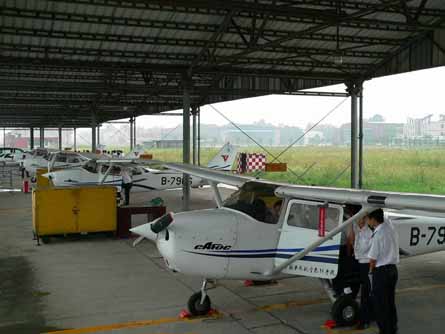Can China open enough flying schools - and, until it does, can overseas trainers manage the demand?
China has been turning to overseas ab initio training schools to help meet its demand for new commercial pilots partly because some of the schools that were planning to start in-country have so far failed to receive the necessary regulatory approvals.
The country still only has two ab initio schools approved by the Civil Aviation Administration of China (CAAC). Such schools need CCAR 141 approval under Chinese civil aviation regulations, but so far only the state-controlled CAAC Flying College in Sichuan province and privately owned Beijing PanAm International Academy have this.
|
|---|
China's Cessna 172 trainer fleet is growing exponentially |
Beijing PanAm today has around 500 students and the CAAC Flying College has traditionally produced 850-900 pilots a year, although recently it has increased its intake. But the CAAC's flight standards department has previously forecast that from the end of 2004 to 2010 the country would need to recruit 12,000 pilots.
The CAAC Flying College has responded to the challenge by acquiring additional aircraft so it can train more pilots. Last year it added 42 Cessna 172 Skyhawks, with another 72 to arrive this year. These are used as primary trainers, and the school also has six Cessna Citations for advanced training.
While the CAAC Flying College is at Guanghan in Sichuan, Beijing PanAm's 500 students are spread across three sites - its main campus is at Shijiazhuang Zhengding airport, about 260km (160 miles) south of Beijing. In mid-2006, the college opened a campus at Binzhou in Shandong province and last September it started a school in Baotou in Inner Mongolia.
Beijing PanAm general manager operational affairs Hamish Wang says the academy wants to establish campuses in two or three more places because "we need to increase capacity for training and fulfil demand across the country". The school operates 60 Diamond light aircraft, plus one Beechcraft King Air B200 and two Citations, and this year plans to add another 40 Diamonds, he says.
One of the challenges the school faces is the 17% value-added tax on small aircraft, says Wang. There is also 5% import tax, so the total tax bill for each aircraft is 22.85%. Another problem is China's airspace restrictions, he says. This is a common concern among operators because the country's airspace is still largely controlled by the military.
Lack of airspace
The lack of available airspace has made it hard for China's general aviation sector to develop and as a consequence relatively few people have a private pilot's licence. Those wishing to become airline pilots generally have no flying experience before enrolling and, in the case of Beijing PanAm, have to do a 14-month course that involves securing a private pilot's licence then a commercial pilot's licence.
Unlike in Western countries, people in China are generally unable to get bank loans to pay for pilot training courses. This means most students have a sponsor, usually an airline. Carriers recoup the training costs by having the pilot sign a contract requiring them to work for the airline for several years and in some cases their entire flying careers.
Another hurdle training schools have to overcome is the global shortage of skilled flight instructors. It takes "about three months" for foreign instructors to have their qualifications recognised, says Wang, depending how well they pass the CAAC examination.
Despite these challenges, the shortage of pilots is so severe some airlines have looked into getting involved in running pilot training schools. Hainan Airlines in 2005 was planning to buy into Flying Dragon, a general aviation company in Harbin working to establish the Flying Dragon Flight Academy. Manufacturer Harbin Aircraft and China's ministry of geological resources remain the owners, but Hainan Airlines no longer plans to buy in, according to Flying Dragon.
The academy did open and trained about 50 pilots, but an official in the CAAC's flight standards department says it closed the school last year as it needs CCAR 141 approval. Flying Dragon says it is now being "audited" for CCAR 141 and expects to be able to train 50-100 pilots each year at two campuses, one at Jiamusi in far north-eastern China, near the border with Russia, and the other in Shandong province.
Shandong is home to another would-be pilot training school, Qingdao Jiutian Spartan Flight Academy in the port city of Qingdao. This is a joint venture between the US Spartan School of Aeronautics, Chinese carrier Shandong Airlines and private Chinese company Sunny Forest. The school has so far failed to secure CCAR 141 certification, but might do so "in the future", says the CAAC official.
That there are only two schools in China with the necessary CAAC approval means carriers are forced to rely on overseas facilities. The CAAC says it has granted CCAR 141 certification to 18 overseas schools - seven in the USA, five in Australia, four in Canada and one in Spain.
State-owned China Southern Airlines owns 100% of China Southern West Australian Flying College, which has two campuses - in Jandakot and in Merredin near Perth. The college trains pilots only for the China Southern Airlines group and in the past 15 months has almost doubled its student intake from 120 to 230.
Burt Hoogland, general manager administration, says the school increased its intake using existing resources, but recently added four Piper Seminoles to its fleet of Grob G115Cs and Cessna Citations. The school has no plans to add aircraft this year, but faces the challenge of getting flying instructors and aircraft mechanics, he says.
Source: Flight International











































